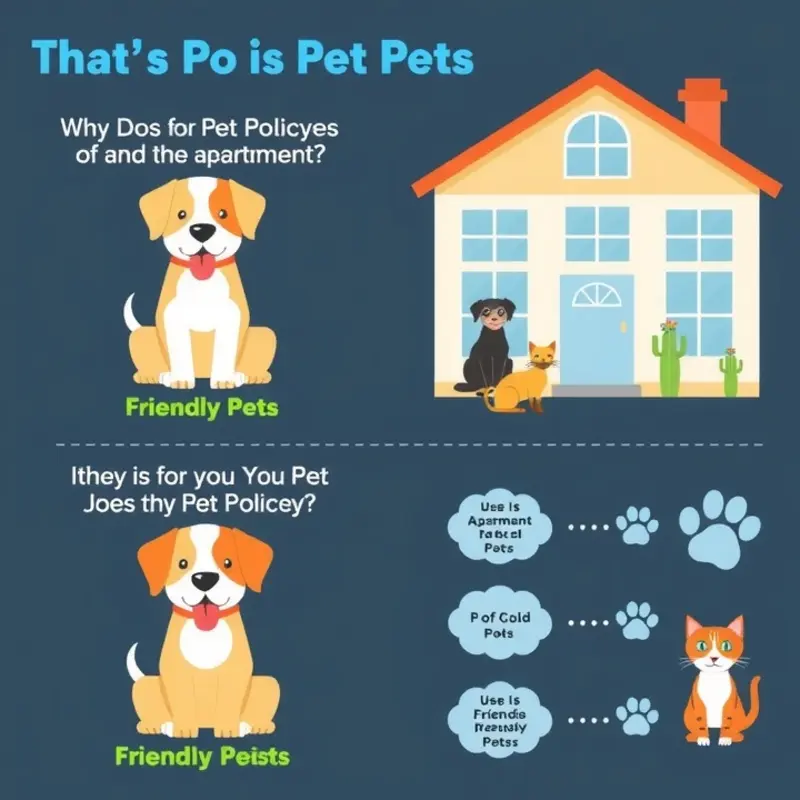Ah, the great apartment hunt. You’ve got your eye on that chic one-bedroom, complete with a rooftop patio and a coffee shop right downstairs. But then it hits you like a wayward frisbee: What about Fido? Apartment pet restrictions can often feel like a minefield, particularly for first-time renters and young professionals who are eager to settle into their next abode – with their fur babies, of course. Whether you’re a young couple with an adorable golden retriever, or a family with the world’s most inquisitive kitten, navigating through various rental policies can be tricky. Fear not! This guide breaks down what you need to know about pet policies in U.S. apartments, ensuring both you and your pet find the perfect space to call home. Let’s take a light-hearted but informative approach to making renting a place that accommodates your four-legged friends just a bit easier!
Understanding Pet Policies: The Good, The Bad, and The Fuzzy

Navigating apartment pet policies can feel like entering a labyrinth with no clear path. Such policies can vary widely, often leaving potential renters confused and overwhelmed. Understanding these policies is key to a smooth rental process when you have a furry friend who’ll call the apartment home.
Firstly, pet policies often define the type and size of pets allowed. Some apartments only accept specific animals like cats or dogs, while exotic pets such as reptiles or birds might be prohibited. It’s common to find size or weight limits, especially for dogs. Apartments may set a threshold, often around 25 to 50 pounds, potentially excluding larger breeds.
Additionally, certain breeds might be restricted. This is where policies get fuzzy; breed restrictions typically encompass dogs considered aggressive, like pit bulls, rottweilers, or German shepherds. These rules aim to limit liability, though they can paint with a broad brush, affecting many gentle pets without reason. For those with unique or unconventional pets, referencing local laws or consider pet insurance to ease concerns landlords might have.
Pet deposits and fees are another crucial component. While most pet-friendly rentals will have an additional deposit requirement, it’s essential to distinguish between refundable and non-refundable fees. Typically, a pet deposit ranges from $200 to $500. However, renters should ask whether these deposits protect agains damage only, or if they extend to general cleanliness concerns as well.
Rent might also incur a ‘pet rent’ surcharge, an extra fee added to your monthly rental price. This fee can range from $25 to $50 per pet each month. Accumulated over a lease term, this can significantly affect one’s budget. Negotiating the terms can sometimes lessen these costs. Consider referencing resources like Pet-Friendly Indoor Activities for creative ways to manage pet needs indoors to assure a potential landlord of diligent pet care.
Exceptions and negotiations are possible. Building good rapport with the landlord or property manager can sometimes bend the rules in your favor. Offering references from previous landlords or additional cleaning deposits can demonstrate your commitment to maintaining the property.
Finally, consider renters’ insurance policies with pet coverage. This can reassure landlords about potential liabilities. Some insurers offer coverage that includes pet damage or incident coverage, usually part of broader renter’s insurance packages.
Understanding and dissecting these components empowers you in your hunting process. Always read through the pet policies thoroughly before signing anything, and don’t be afraid to ask questions. With patience and diligence, you and your pet will find the perfect place to call home.
Tips for Finding Your Ideal Pet-Friendly Apartment

Finding a pet-friendly apartment can feel daunting, especially with the varying pet policies from state to state. There are several effective strategies to help streamline your search and ensure both you and your pet can live comfortably.
Start by defining your needs. Consider the size and type of your pet, as landlords often impose restrictions based on weight or breed. Knowing what is essential for your pet allows you to set clear priorities when evaluating potential apartments.
Next, leverage online resources designed for pet owners. Several websites cater specifically to pet-friendly rentals, allowing you to filter options by pet policy criteria. Expand your search by visiting general apartment listing sites, emphasizing pet-friendly filters to narrow down your options.
Joining local pet owner groups online can also provide valuable insights. Use platforms like social media and community forums to connect with other pet owners who can offer recommendations based on personal experiences. These groups often share listings you may not find through traditional methods and give firsthand accounts of how pet-friendly specific properties are.
Networking with local realtors can provide an advantage. Realtors with knowledge of pet-friendly properties can navigate complex policies and assist in negotiations with property managers. They may have insider information on new listings that cater to pet owners.
Consider working with smaller landlords or private property owners who might be more flexible with pet policies. Instead of large apartment complexes with strict guidelines, smaller buildings often provide more room for negotiation. Make a strong case by highlighting your responsible pet ownership qualities, such as providing references from previous landlords or documentation of your pet’s training and vaccinations.
Incorporate your pets into the decision-making process. Visit potential neighborhoods and observe how friendly they are to pets. Look for nearby parks, pet-friendly cafes, and veterinary services to gauge suitability. Engaging with the local environment provides a clearer picture of day-to-day living with your pet.
Be proactive and prepared to provide detailed information about your pet. Having a ‘pet resume’ ready can set you apart from other applicants. Include photos, medical records, and references to illustrate that your pet is well-behaved and has been a responsible tenant in previous homes.
When you’ve narrowed down your options, take a closer look at the amenities and consider whether they truly accommodate your pet-related needs. Some apartments may offer facilities like dog parks or grooming stations, enhancing your pet’s living experience.
Renters should also be aware of financial implications. Budget for potential pet deposits or monthly pet fees. Understanding the financial aspect helps you avoid surprises and manage a realistic budget.
For additional tips on living with pets in apartments, explore our guide on apartment-friendly indoor activities. It offers creative ways to keep your pet entertained and well-adjusted.
By following these strategies, you’ll increase your chances of finding a space where you and your pet can thrive. Balance your search between digital resources and direct connections to ensure no stone is left unturned in your pursuit of a pet-friendly community.
Final words
There you have it! Armed with the knowledge of apartment pet restrictions, and a few tips on finding that perfect rental, you’re now ready to start your housing adventure with your furry friend by your side. Remember, the search may take some time, but it’s crucial to stay optimistic and persistent. After all, a friendly paw-shake at the front door is just around the corner. Happy apartment hunting!









